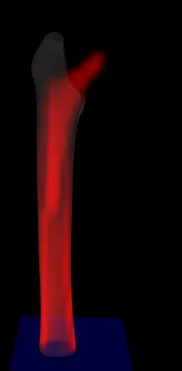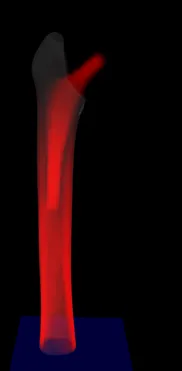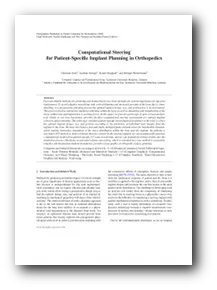Computational Steering for Patient-Specific Implant Planning in Orthopedics
Christian Dick, Joachim Georgii, Rainer Burgkart*, Rüdiger Westermann
Computer Graphics and Visualization Group, Technische Universität München, Germany
*Klinik u. Poliklinik für Orthopädie u. Sportorthopädie am Klinikum Rechts der Isar, Technische Universität München, Germany
Background
Fast and reliable methods for predicting and monitoring in-vivo bone strength are of great importance for hip joint replacement. To avoid adaptive remodeling with cortical thinning and increased porosity of the bone due to stress shielding, in a preoperative planning process the optimal implant design, size, and position has to be determined. This process involves interactive implant positioning within the bone as well as simulation and visualization of the stress within bone and implant due to exerting forces. In this paper, we present a prototype of such a visual analysis tool, which, to our best knowledge, provides the first computational steering environment for optimal implant selection and positioning. This prototype considers patient-specific biomechanical properties of the bone to select the optimal implant design, size, and position according to the prediction of individual load transfer from the implant to the bone. We have developed a fast and stable multigrid finite-element solver for hexahedral elements, which enables interactive simulation of the stress distribution within the bone and the implant. By utilizing a real-time GPU-method to detect elements that are covered by the moving implant, we can automatically generate computational models from patient-specific CT scans in real-time, and we can instantly feed these models into the simulation process. Hardware-accelerated volume ray-casting, which is extended by a new method to accurately visualize sub-hexahedron implant boundaries, provides a new quality of orthopedic surgery planning.

voxels/hexahedron
2,257 hexahedra

voxels/hexahedron
14,277 hexahedra

voxels/hexahedron
88,783 hexahedra

voxels/hexahedron
520,416 hexahedra
Acknowledgments
The first author is funded by the TUM International Graduate School of Science and Engineering (IGSSE). We thank our cooperation partners at the Chair for Computation in Engineering, TUM.

Associated publications
Computational Steering for Patient-Specific Implant Planning in Orthopedics
C. Dick, J. Georgii, R. Burgkart, R. Westermann, Visual Computing for Biomedicine 2008
[Bibtex][PDF]
Winner of Best Paper Award